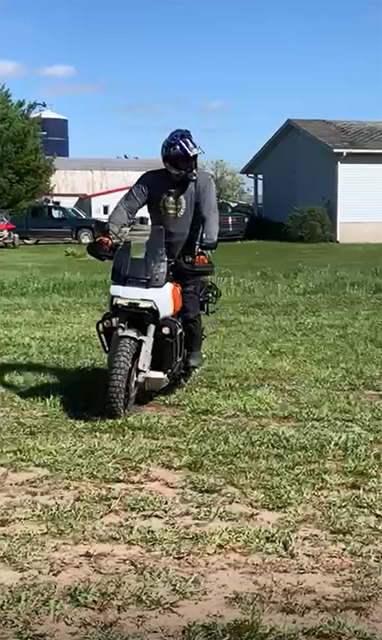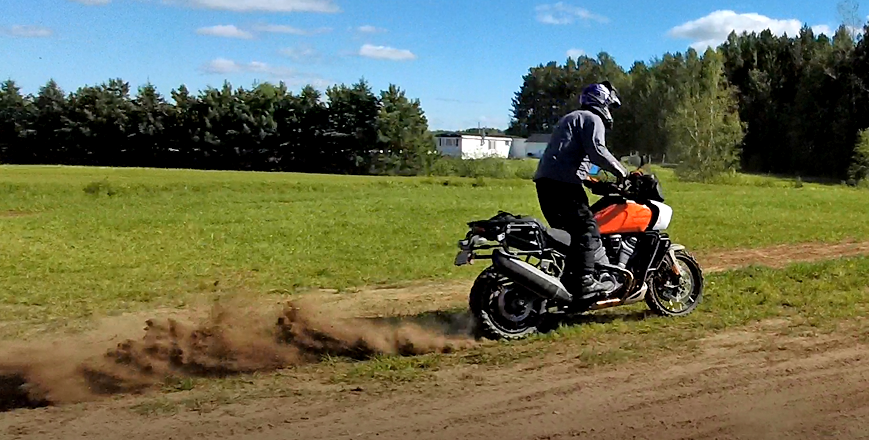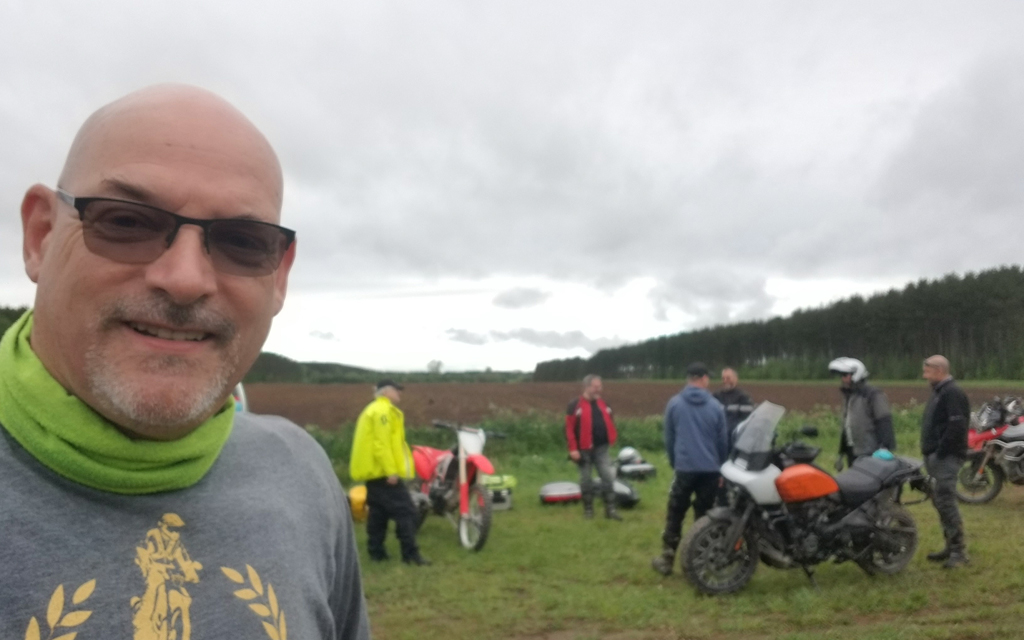*This article was published in Vol. 51 No. 6 of Cycle Canada digital magazine.
Thanks to Patrick Lavigne from Léo Harley, who invited me to the launch of the Pan America and offered to let me ride it for a few days, I have been able to try out the new Harley-Davidson in various conditions. Whether on asphalt, dirt roads or in the context of an Adventure Driving Training with my friend Don Pronovost of the MXPro School, the Pan America showed a playful nature at all times. With an OK from the Léo Harley team, I offered a few of my regular on and off-road riding buddies the chance to ride the Pan Am, and their smiles were telling.
So here it is, the much-talked-about interpretation of an adventure touring motorcycle by Harley-Davidson. Well, the machine does not go unnoticed and the finish is high-quality.
To get the S model ready according to my expectations, it was fitted with appropriate tires and the riding position was adjusted. With 50/50 Anakee Wild tires, raised bars, controls adjusted accordingly and rubbers removed from the footpegs, it adopted a different personality, better suited to the standing position. I am 1.88 m tall and weigh a little over 100 kg, and I felt immediately at ease. I did not feel the need to raise the bars higher; they are wide but they don’t affect the turning circle when you move them to the stops. The active suspension that lowers the bike at stops does a fine job; it’s unobtrusive.

As you get closer, you notice that all the components are neatly presented, but you also realize that for serious off-road riding, there are obvious improvements to be made in terms of protection. But don’t worry, Harley thought about it all and will offer what’s needed to armour the bike extensively. As sold, it is ready to fly through forest roads such as Marc Chartrand’s Trans Québec Trail (TQT) network. The rest is a matter of experience. Keep in mind that this is a big machine!
Since the technical aspects of the Pan Am have been well covered in previous articles, I will concentrate on my riding impressions.
On board, you quickly feel at ease, thanks to the great comfort and riding position. As for the seat, I know of a few prestigious brands that could take lessons from the Pan Am. Depending on the mode selected, the engine can be described as velvety and raging as the revs go up. You constantly feel its presence, and I am saying this in a positive way. My friend Robert described it as the motorcycle version of a ’70s muscle car engine, which gives this adventure bike a uniquely American character. The exhaust note is well controlled and won’t bother people. On the bike, though, you’re surrounded by the exhilarating music of the V-2 when accelerating; beware, this can be addictive!
On the road, the Sport mode is very, very enjoyable — the engine is not limited and the suspension is tuned to sport riding, or more relaxed in Touring mode. You are somewhat exposed to the wind, as with most adventure bikes. It is possible to personalize the different functions, engine, suspension, etc., with the many available options. The preset road and off-road modes are well balanced. As various people observed, there is a slight engine reaction delay when you twist the throttle, but nothing problematic once you know about it.
A Harley being a Harley, the liquid-cooled engine produces a lot of heat at stops and at low speeds, especially from the right side. If you are used to pulling your leg out on that side, beware of the exhaust pipe because it could melt synthetic clothing. Once riding, you forget about the heat.

The comments we got from the on-road part of the test (with 50-50 tires) referred to comfort, manoeuvrability, exciting engine, heat, tractable engine, impressive Sport driving mode, and really powerful and progressive brakes. As for the look, it has been described as intimidating at first, but then very attractive. The quality of the panniers has been noted, too, though they make the bike wider and the high position of the sidecases calls for an adaptation period. Exhaust noise control was also much appreciated. One more positive aspect: lights and adaptative auxiliary headlights that pivot to light up the shoulders in curves. And the flashers stay clearly visible in daylight, enhancing the ever so important visibility factor for motorcyclists.
I tried the Off-Road mode on dirt roads: the Pan Am managed to absorb holes and bumps with ease and allowed me to maintain an “inspiring” speed. Traction Control seemed a bit invasive to me, no matter the riding mode selected. On the other hand, it allows the pilot to keep the bike predictable and in control. In simulated emergency braking on gravel roads (and other surfaces), the brakes were powerful and the appropriate riding mode kept them well under control.
In pure off-road conditions, in the context of the MXPro training, the good behaviour of the Pan America has been a surprise for many of us. I was not faced with any particularly different reactions, and I certainly did not reach the limits of the motorcycle. This is a big machine that behaves nicely off-road. My friends had the opportunity to try it back-to-back with their own bikes, all equipped with appropriate tires. Some of them felt more at ease with the Pan Am. And all of them said that this engine is a great success, and that it adds a lot to the fun of riding this bike. Getting used to the Pan Am is easy and the standing position allowed good control when practising manoeuvres. Our teacher, Don, kind of made fun of me when he sat on the passenger seat, holding my left arm behind me while I had to perform figure-eights.
Personally, for a more intense off-road use, I think it would be good to set a User mode with ABS on up front, and off at the rear. Also, the Traction Control should be adjusted in order to be less invasive, or simply turned off depending on the situation. Otherwise, you have to disable it each time you restart the machine.
On the road conclusion
The Pan America is aimed at a wide range of riders. With its road performance, great engine, cruise control, heated grips, comfortable seat, numerous riding modes, active suspension, etc., I can easily imagine it becoming a strong sport touring contender against other brands.
Off-road conclusion
In its stock form, the Pan America will fulfill most expectations for discovering forest roads in a safe and comfortable manner.
With adequate preparation for more demanding trail rides, and taking into account the physical limitations of the bike and the pilot’s experience, we are likely to see it just about everywhere in the woods.
What’s next?
Now Harley has to attract a demanding clientele to this new option, and build its reputation of reliability. The American firm won a first challenge by creating a bike that’s original, functional and inspiring, at a competitive price. There is still work to be done before climbing on the first step of the adventure touring motorcycles podium, but at this level it’s all in the eye of the beholder.
Bravo. And respect.






